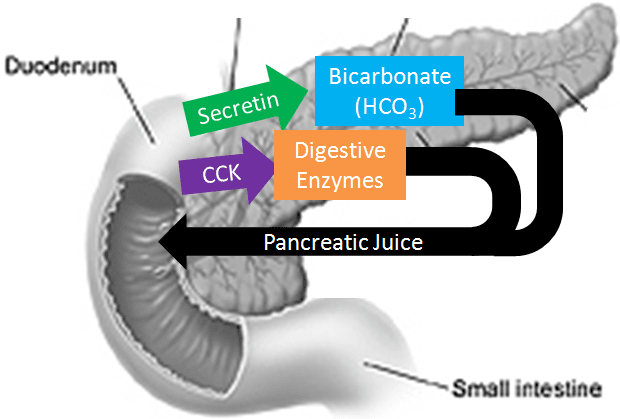 Gastrointestinal hormones explained
Gastrointestinal hormones explained
Gastrointestinal hormones are hormones produced by the cells in the digestive tract, also known as the gastrointestinal (GI) tract. These hormones play a crucial role in regulating various functions related to digestion, appetite, and overall gut function. They act as messengers that help coordinate the complex processes of digestion and absorption of nutrients. Here’s a brief explanation of gastrointestinal hormones:
-
-
- Ghrelin: Often referred to as the “hunger hormone,” ghrelin is produced mainly in the stomach and signals hunger to the brain. Its levels increase before meals and decrease after eating.
- Leptin: Produced by fat cells, leptin helps regulate energy balance and appetite. It signals to the brain that the body has enough energy stored and influences feelings of fullness.
- Cholecystokinin (CCK): CCK is released from the small intestine in response to the presence of fats and proteins in the digestive tract. It stimulates the gallbladder to release bile, which aids in fat digestion, and it also reduces appetite.
- Gastrin: Produced in the stomach, gastrin stimulates the secretion of gastric acid, which is essential for breaking down food. It also helps regulate the movements of the stomach muscles.
- Secretin: Secretin is released from the small intestine in response to acidic chyme (partially digested food) entering the duodenum. It triggers the pancreas to release bicarbonate-rich fluids that neutralize stomach acid.
- Motilin: This hormone is produced in the small intestine and promotes the contraction of the smooth muscles of the digestive tract, aiding in the movement of food through the intestines.
- Peptide YY (PYY): Released from the small and large intestines, PYY helps regulate appetite by signaling feelings of fullness after eating.
- Glucagon-Like Peptide-1 (GLP-1): Produced in the small intestine, GLP-1 stimulates insulin secretion and helps regulate blood sugar levels. It also slows down gastric emptying, contributing to feelings of fullness.
- Glucose-Dependent Insulinotropic Peptide (GIP): Also produced in the small intestine, GIP stimulates insulin release after eating and helps regulate blood sugar levels.
-
These gastrointestinal hormones interact with each other and with the nervous system to coordinate the digestion and absorption of nutrients, regulate appetite, and ensure the proper functioning of the digestive system. Their balance is essential for maintaining overall health and proper metabolism.
Education Blog for Personal Trainers Education
By: Joe Antouri
PROPTA / Professional Personal Trainers Association
Worldwide Institute for Fitness & Nutrition for Education and Certification
Explicación de las Hormonas Gastrointestinales
Las hormonas gastrointestinales son hormonas producidas por las células del tracto digestivo, también conocido como el tracto gastrointestinal (GI). Estas hormonas desempeñan un papel crucial en la regulación de diversas funciones relacionadas con la digestión, el apetito y la función general del intestino. Actúan como mensajeros que ayudan a coordinar los complejos procesos de digestión y absorción de nutrientes. Aquí tienes una breve explicación de las hormonas gastrointestinales:
-
-
- Ghrelina: A menudo llamada la “hormona del hambre”, la ghrelina se produce principalmente en el estómago y señala al cerebro cuando se tiene hambre. Sus niveles aumentan antes de las comidas y disminuyen después de comer.
- Leptina: Producida por las células de grasa, la leptina ayuda a regular el equilibrio energético y el apetito. Indica al cerebro que el cuerpo tiene suficiente energía almacenada e influye en la sensación de saciedad.
- Colecistoquinina (CCK): La CCK se libera desde el intestino delgado en respuesta a la presencia de grasas y proteínas en el tracto digestivo. Estimula a la vesícula biliar para liberar bilis, que ayuda en la digestión de grasas, y también reduce el apetito.
- Gastrina: Producida en el estómago, la gastrina estimula la secreción de ácido gástrico, que es esencial para descomponer los alimentos. También ayuda a regular los movimientos de los músculos estomacales.
- Secretina: La secretina se libera desde el intestino delgado en respuesta a la entrada de quimo ácido (alimento parcialmente digerido) en el duodeno. Estimula al páncreas para liberar fluidos ricos en bicarbonato que neutralizan el ácido estomacal.
- Motilina: Esta hormona se produce en el intestino delgado y promueve la contracción de los músculos lisos del tracto digestivo, ayudando al movimiento de los alimentos a través de los intestinos.
- Péptido YY (PYY): Liberado desde el intestino delgado y grueso, el PYY ayuda a regular el apetito al indicar la sensación de saciedad después de comer.
- Péptido Similar al Glucagón-1 (GLP-1): Producido en el intestino delgado, el GLP-1 estimula la secreción de insulina y ayuda a regular los niveles de azúcar en sangre. También ralentiza el vaciado gástrico, contribuyendo a la sensación de saciedad.
- Péptido Insulinotrópico Dependiente de la Glucosa (GIP): También producido en el intestino delgado, el GIP estimula la liberación de insulina después de comer y ayuda a regular los niveles de azúcar en sangre.
-
Estas hormonas gastrointestinales interactúan entre sí y con el sistema nervioso para coordinar la digestión y absorción de nutrientes, regular el apetito y asegurar el funcionamiento adecuado del sistema digestivo. Su equilibrio es esencial para mantener la salud general y un metabolismo adecuado.
Blog de educación para la formación de entrenadores personales
Por: Joe Antouri
PROPTA / Asociación Profesional de Entrenadores Personales
Instituto Mundial de Fitness y Nutrición para la Educación y Certificación

